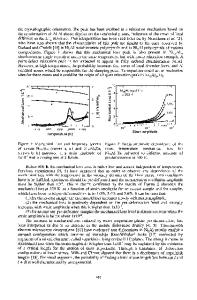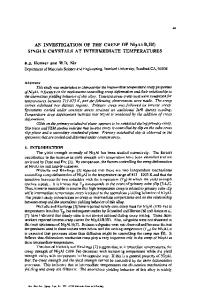Hydrogen-enhanced dislocation velocities in Ni 3 Al single crystals
- PDF / 181,684 Bytes
- 3 Pages / 612 x 792 pts (letter) Page_size
- 16 Downloads / 452 Views
MATERIALS RESEARCH
Welcome
Comments
Help
Hydrogen-enhanced dislocation velocities in Ni3Al single crystals C.B. Jiang, S. Patu,a) Q.Z. Lei, and C.X. Shi State Key Laboratory for Fatigue and Fracture of Materials, Institute of Metal Research, Chinese Academy of Science, Wenhua Road 72, Shenyang 110015, People’s Republic of China (Received 17 May 1999; accepted 4 October 1999)
The average dislocation velocity in hydrogenated Ni3Al single crystals was directly measured as a function of resolved shear stress (RSS) at room temperature (293 K) by the etch-pit technique. It was found that the dislocation velocity with hydrogen is about 5–25 times faster than that without hydrogen for the same RSS, and hydrogen decreases activation energy for dislocation motion in Ni3Al single crystals. The reason hydrogen can enhance dislocation velocity in this compound is briefly discussed. These preliminary results quantitatively provide the first evidence of hydrogen-enhancing dislocation mobility in Ni3Al material.
It is well known that hydrogen in materials dramatically affects their mechanical properties1–3 and assumed to be closely related to the dislocation mobility in the materials. Therefore, fundamental study of dislocation mobility under hydrogen influence is quite important to understand the hydrogen effect on deformation and fracture in materials. There have been a few experiments on dislocation mobility under hydrogen influence using in situ TEM studies,4,5 macroscopic stress–strain curves,6 measurement of thermally activation dislocation motion,7 and theoretical calculation of hydrogen shielding of elastic stress center.8 Despite many observation of hydrogen-enhanced dislocation mobility in TEM specimens, no quantitative study of the influence of hydrogen on the dislocation mobility in materials has been reported yet. Direct measurement of the dislocation velocity is required to provide quantitative description of the dislocation mobility in many materials.9 In this paper, we directly measure the dislocation velocity under electrolytically charged hydrogen conditions. The materials and experimental technique used in this study are exactly the same as used in the previous work.10 The Ni3Al (Al, 21.0 at.%; Ti, 3.9 at.%; balance Ni) single crystal was grown by the Bridgman method. The as-grown single-crystal rod was homogenized in Ar at 1473 K for 7 days. The specimens were cut from the rod to a rectangular shape of about 1.0 × 3.0 × 16.0 mm, annealed in Ar at 1523 K for 7 days, and then cooled by 1 K/min to reduce the prior dislocation density. These specimens were mechanically polished and then elec-
a)
Address all correspondence to this author. e-mail: [email protected] J. Mater. Res., Vol. 15, No. 1, Jan 2000
http://journals.cambridge.org
Downloaded: 17 Mar 2015
tropolished to remove the surface damage. The specimens used for measuring the dislocation velocities had a dimension of 0.5 × 3.0 × 16.0 mm with the longest side along [110] and the flat surface on (001). The specimens were chemically etched at room temp
Data Loading...










